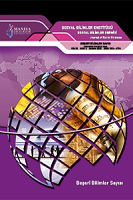(De)Humanized Androids as Monsters in Garland’s Ex Machina
(De)Humanized Androids as Monsters in Garland’s Ex Machina
Author(s): Mustafa Fatih Dalyan, Nilsen GökçenSubject(s): Sociology of the arts, business, education, Film / Cinema / Cinematography, Sociology of Politics, Sociology of Art
Published by: Celal Bayar Üniversitesi Sosyal Bilimler Enstitüsü
Keywords: Gothic; Science Fiction; Ex Machina; Alex Garland;
Summary/Abstract: Ex Machina (2015) is a postmodern Gothic sci-fi movie by Alex Garland, implicitly illustrating the workings of humanization, dehumanization, and marginalization through its android character Ava. Ava’s interaction with people reveals humanity’s biased perspectives and problems. She enables the audience to see that inorganic anthropomorphic bodies mimicking human behaviors and cognitive skills converge on humans and become strangely humanized. Yet creating uncanny sensations in humans, these bodies become a new group of “others” who belong outside the boundaries of humanness so much so that they exist on the threshold of monstrosity. Furthermore, due to their anthropomorphic appearance, they cannot avoid human hierarchies of race and gender. However, once they become perceived as humans, they learn to use human methods to survive including the wicked ones. Ex Machina thus demonstrates that the process of dehumanization not only creates injustices to dehumanized groups but results in the dehumanization of those that apply it to Others, for it is they that become “less than human” by their inhumane acts
Journal: Celal Bayar Üniversitesi Sosyal Bilimler Dergisi
- Issue Year: 20/2022
- Issue No: 02
- Page Range: 169-183
- Page Count: 20
- Language: English

